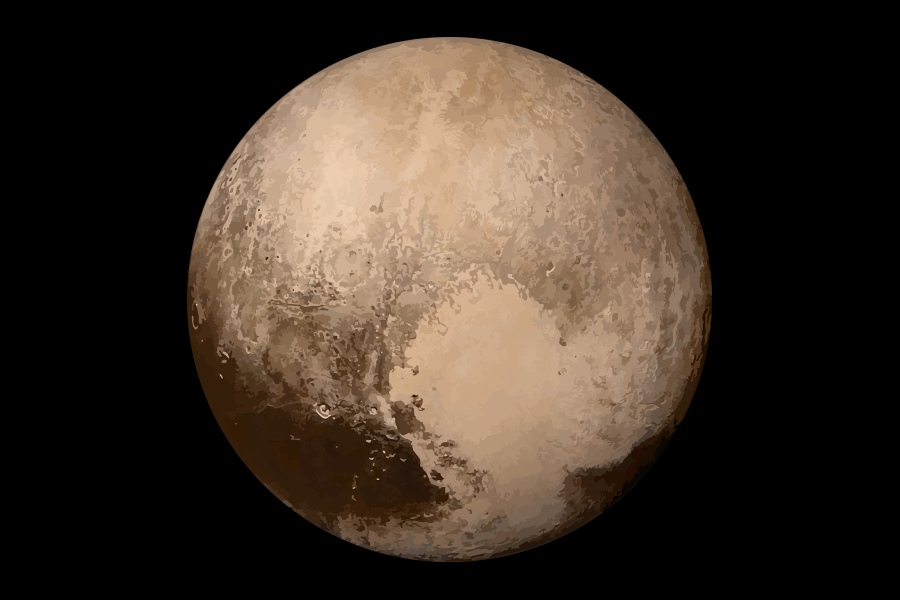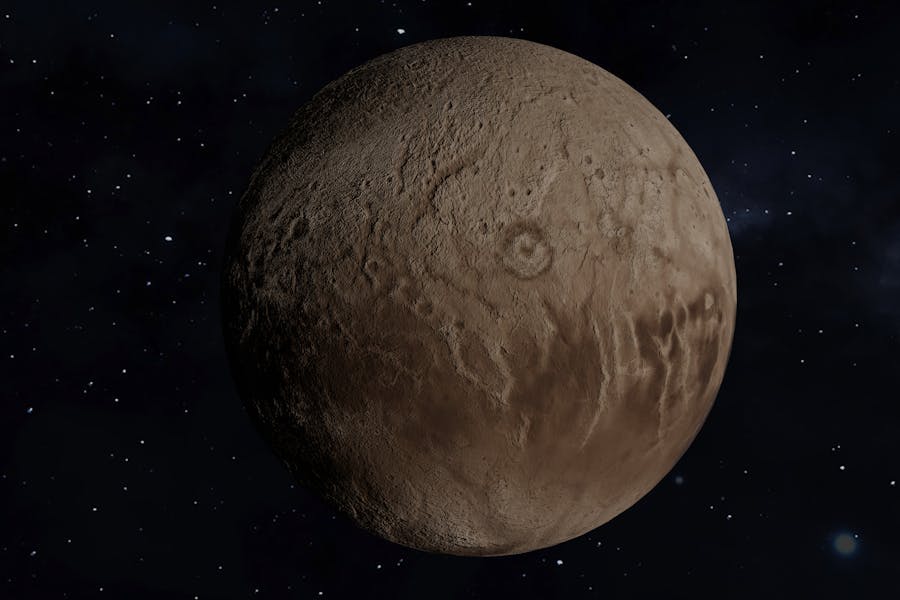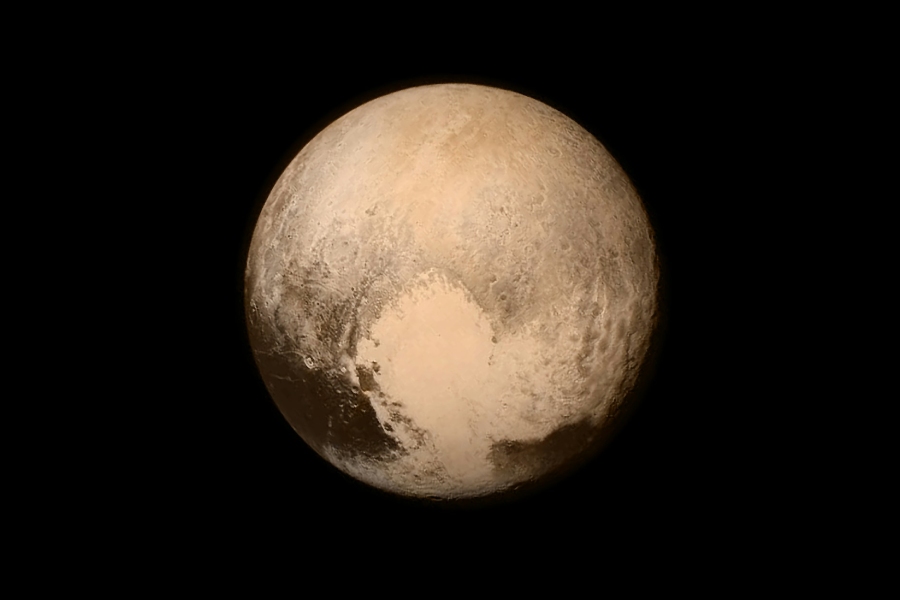How did Pluto, that lonely ice world over three billion miles from the Sun, come to be? This distant dwarf planet is only two-thirds the size of our own Moon. But it has intrigued scientists and the public alike since its discovery in 1930.
Pluto’s small size and odd orbital characteristics have made its origins a puzzle. In this article, we’ll look at the different theories that attempt to explain how did Pluto form in our Solar System.
Could it have begun life as a moon of Neptune that was knocked out of orbit? Or did the countless small icy bodies beyond Neptune gradually combine to form Pluto?
While these hypotheses provide possible answers, a definitive explanation of Pluto’s origins remains elusive to this day. How did this diminutive world emerge so far from the Sun? As we explore this intriguing question, we’ll find that Pluto still harbors many mysteries. This is over 90 years after its initial detection.
How Did Pluto Form?
How did Pluto form? Pluto, emerging about 4.6 billion years ago, originated from ices like water, methane, and nitrogen, along with rocks in the outer Solar System’s cold expanse.
The gradual gathering and cohesion of these materials resulted in the formation of this small, icy world that we call Pluto. This process of accumulation and creation aligns with the natural progression that shaped various entities within our cosmic neighborhood.

Theories on Pluto’s Formation
Overview of different theories
There are several major theories that attempt to explain how Pluto formed in our Solar System. These range from models focused on local accretion of ice and rock to more complex ideas involving the migration of larger planets. We will summarize the key proposals below.
Initial accretion model
The initial accretion model suggests that Pluto formed out of the solar nebula. This is the cloud of gas and dust that surrounded the young Sun. Small particles would have slowly collided. Over time, their gradual accumulation created larger objects, eventually forming Pluto and other Kuiper belt objects.
This model may explain Pluto’s formation. Pluto likely emerged from planetesimals beyond Neptune’s orbit. These icy leftovers from our solar nebula slowly merged over tens of millions of years.
Core-accretion model
The core-accretion model proposes that a rocky core formed first. This then rapidly attracted surrounding ice and gas to become Pluto. This mirrors theories for gas giant formation. It can explain Pluto’s rock-ice differentiation.
This model suggests Pluto began as a large rocky planetary core. Radioactive elements heated Pluto’s interior, causing rock and ice layers to separate. Later, Pluto’s moderate gravity attracted additional volatile ices and gases. This gave Pluto its thick atmosphere and surface ice seen today.
Migration theory for planet nine
Some models involve outward planet migration. A hypothetical Planet Nine may have pushed Pluto into its distant eccentric orbit when the Solar System was still taking shape. This would neatly account for Pluto’s odd orbit.
But Planet Nine remains undiscovered. If Planet Nine migrated outwards, its gravity may have seized Pluto. Pluto could have been tossed into a more elliptical orbit tilted steeply to the Solar System’s plane. Computer simulations show Pluto’s orbit can arise from Planet Nine perturbations.
Interaction with other celestial bodies
Pluto may have started as a moon of Neptune. It could have been knocked into an independent orbit by collisions. Encounters with other Kuiper belt objects can drive migration, too. But no specific events have been identified from the ancient Solar System.
Influence from passing stars and molecular clouds
Beyond the Solar System, stars and interstellar clouds may have played an important role. Their gravitational pull or solar wind could tug objects like Pluto into unstable orbits when the Sun was young.
However, the odds of such encounters are extremely low. Gravitational tugs between the Sun and a close star could pull on Pluto. This would stretch its orbit into an exaggerated ellipse or tilt it dramatically.
Initial Accretion Model Theory
The initial accretion model describes the gradual growth of planets from smaller objects. It outlines how cosmic dust condensed into grains. These grains collided and stuck together through weak chemical bonds.
The grains formed larger chunks called planetesimals. Planetesimals are combined into embryonic planets. These embryos continued accreting material. This process led to all the planets in our Solar System.
Relevance to Pluto’s formation
This model may explain Pluto’s formation. Pluto likely emerged from planetesimals beyond Neptune’s orbit. These icy leftovers from our solar nebula slowly merged over tens of millions of years.
Their accumulation formed Pluto and fellow Kuiper belt objects. This growth was enhanced by volatile materials like methane freezing onto objects out there.
Key concepts and processes
The model assumes planetesimals have weak gravity fields. This lets them combine gently through low-speed accretion. Solar nebula instabilities caused the growth of some planetesimals before others.
Radioactive materials in accreting bodies supplied internal heating. This allowed further differentiation and chemical changes.

Core-Accretion Model Theory
The core-accretion model proposes a bottom-up formation of planets. It states that small dust grains stuck together to form larger rocky bodies called planetesimals. The largest of these planetesimals generated enough internal heat to melt and differentiate.
Their dense cores later rapidly pulled in gas from the solar nebula. This led to the giant planets coalescing around large solid cores.
Implications for Pluto’s formation
This model suggests Pluto began as a large rocky planetary core. Radioactive elements heated Pluto’s interior, causing rock and ice layers to separate. Later, Pluto’s moderate gravity attracted additional volatile ices and gases.
This gave Pluto its thick atmosphere and surface ice, as seen today. The process mirrors gas giant origins but on a smaller scale.
Scientific evidence and support
Studies of Pluto’s density and composition back the core model. Its higher density requires a high rock-to-ice ratio. Spectroscopy also reveals surface ices of nitrogen, methane, and carbon monoxide.
These likely froze out from Pluto’s early extended atmosphere. The New Horizons spacecraft found signs of past tectonic and cryovolcanic activity as well. This points to a geologically active differentiated interior.
Migration Theory for Planet Nine and Its Impact on Pluto’s Evolution
Some models propose a distant Planet Nine tilted orbits in the outer solar system. This hypothetical giant planet may have formed closer to the Sun.
It was then ejected outwards through gravitational interactions early on. This migration could have dramatically reshaped orbits of Kuiper belt worlds as Planet Nine passed through.
How Planet Nine’s migration could affect Pluto
If Planet Nine migrated outwards, its gravity may have seized Pluto. Pluto could have been tossed into a more elliptical orbit tilted steeply to the Solar System’s plane.
Computer simulations show Pluto’s orbit can arise from Planet Nine perturbations. Captured as a moon, Pluto may later have escaped into its current lone orbit.
Supporting evidence and criticisms
Pluto’s strange orbit matches expectations of Planet Nine’s interactions. The alignment of some Kuiper belt orbits also points to an unseen outer influence. But without the discovery of Planet Nine, its role remains speculative.
Direct gravitational effects should also have tilted close-in worlds like Earth, unobserved so far. Detractors argue Pluto’s orbit could have other chaotic origins instead.
Interaction With Other Celestial Bodies in the Solar System
Examination of Pluto’s interactions
Pluto may have been shaped by ancient collisions. It could have formed as a moon of Neptune. Models show Neptune migration could have ejected past moons. Pluto occupies a resonance with Neptune, hinting at a shared history.
The orbits also suggest it did not form alone where it resides now. Gravitational kicks from other Kuiper belt objects may have moved Pluto over time.
Potential influences on Pluto’s composition
Early impacts could have chemically mixed or excavated Pluto’s contents. High-velocity collisions strip atmospheres and ice layers large hits add substantial heat. This melts interiors, separating rock and ice.
Debris from crashes may have formed Pluto’s moons. Charon is believed to have originated from impacts, and it’s likely that Pluto also experienced bombardment by impactors before its moons formed.
Notable observations and findings
No specific impact origins have been identified yet. But Pluto and Charon both show extensive geological activity for small worlds. This includes evidence of cryovolcanic flows and deformation of surface ices.
The energy for reshaping terrain long after formation likely comes from internal heat and chemistry created by early collisions. Upcoming missions may uncover more clues about these ancient impacts on Pluto.
Influence From Passing Stars and Molecular Clouds
Explanation of external influences
Beyond the Solar System, passing stars or molecular clouds may have affected Pluto’s evolution. The Sun formed in a dense stellar nursery region. Nearby stars and gas clouds would have been common. Their perturbations could alter the outer Solar System during its development.
Discussion on the effects of passing stars and molecular clouds
Gravitational tugs between the Sun and a close star could pull on Pluto. This would stretch its orbit into an exaggerated ellipse or tilt it dramatically. High stellar winds and radiation could also erode Pluto’s atmosphere when young.
Interstellar clouds could likewise distort Pluto’s orbit through gravitational instability. Shockwaves in these clouds could compress gases into new stars, disrupting nearby systems.
Conclusions and implications
The odds of a disruptive stellar/cloud encounter are extremely low given the vastness of space, and the Sun lacks telltale signatures of such events.
But if Pluto was perturbed early on, effects were likely mild. Its small size makes radical alteration of its orbit difficult compared to gas giants. More modeling is needed on these scenarios’ feasibility versus other formation theories.

Conclusion
There are various theories attempting to explain Pluto’s origins. Some models focus on the accretion of local Kuiper belt material. Others involve the migration of larger bodies like Neptune or the hypothetical Planet Nine.
Each proposal has its set of points supporting and challenging it, contributing to the ongoing discourse on the origin and dynamics of the outer Solar System.
No definitive account has yet emerged on the peculiar genesis of this diminutive, distant world. However, as space missions and astronomical surveys gather more data on Pluto, Charon, and fellow Kuiper belt denizens in the coming years, we may move closer to uncovering the ancient events that ultimately led to Pluto emerging – small yet profound – more than 30 AUs from our Sun.
We hope reflecting on the subject of how did Pluto form has offered you new insight into the mysteries surrounding the Solar System’s outer limits.
